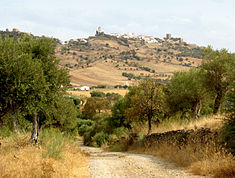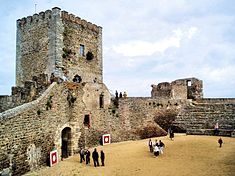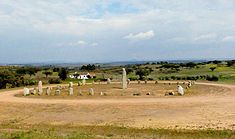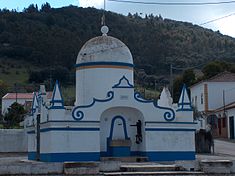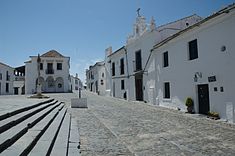- Monsaraz (parish)
-
Monsaraz Civil Parish (Freguesia) A view of the civil parish seat of Monsaraz from the hilltop of Monte Xarez, showing the Castle of MonsarazCoat of armsOfficial name: Freguesia da Monsaraz Country  Portugal
PortugalRegion Alentejo Subregion Alentejo Central District Évora Municipality Reguengos de Monsaraz Localities Aldeia do Outeiro, Horta do Reboredo, Monsaraz, Motrinos Landmarks Alqueva Dam, Castle of Monsaraz River Guadiana Center Monsaraz - elevation 195 m (640 ft) - coordinates 38°26′44.69″N 7°23′21.13″W / 38.4457472°N 7.3892028°W Length 14.62 km (9 mi), North-South Width 8.39 km (5 mi), West-East Population 977 (2001) Density 88.29 / km2 (229 / sq mi) LAU Freguesia/Junta Freguesia - location Largo Dom Nuno Álvares Pereira, Monsaraz, Reguengos de Monsaraz President Junta Jorge Miguel Nunes President Assembleia Nuno Isidro de Ambrósio Pinto Timezone WET (UTC0) - summer (DST) WEST (UTC+1) ISO 3166-2 code PT- Postal Zone 7200-175 Monsaraz Area Code & Prefix (+351) 266 XXX XXX Demonym Monsaratense Patron Saint Santa Maria da Lagoa Parish Address Largo Dom Nuno Álvares Pereira, 9
7200-175 MonsarazWikimedia Commons: Monsaraz Statistics: Instituto Nacional de Estatística[1] Website: http://www.monsaraz.pt/ Geographic detail from CAOP (2010)[2] produced by Instituto Geográfico Português (IGP) Monsaraz is a civil parish and municipal seat of the municipality of the Reguengos de Monsaraz, on the right margin of the Guadiana River in Portuguese Alentejo region, near its border with Spain. Its importance is belied by its population of lessa than 977 residents (2001 Census), covering an area of 88.29 km².
Contents
History
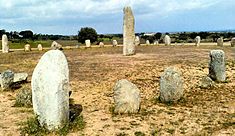 The Megalithic monuments of the Cromlech of Xerez
The Megalithic monuments of the Cromlech of Xerez
Due to its geographic position, the hilltop of Monsaraz always occupied an important place in the history of the municipality, having been occupied by different peoples since the pre-historical record.[3] It’s one of the oldest Portuguese settlements of the southern Portugal, occupied since pre-history, whose examples of permanent habitation include hundreds of megalithic monuments. These include the neolithic remains of: Anta do Olival da Pega, Bulhôa Menhir, Rocha dos Namorados Menhir and Outeiro Menhir. The hill, on which the main settlement is locate, was a pre-historic fortification, or castro, that was the basis of pre-Roman occupation and funerary temples, carved from the local rock.
Monseraz was reorganized during the Roman occupation, but later successively occupied by the Visigoths, Arabs, Mozarabs, Jews, and, after the Reconquista, Christians loyal to the Afonso Henriques. In the 8th century, Monsaraz fell under the dominion of Arab forces who occupied the Iberian Peninsula, becoming known as Saris or Sharish, and following the control of the Taifa of Badajoz (one of the more prominent Arab centres at the time).[3] The name Monsaraz originates from the word Xarez or Xerez, the Iberian transliteration of the Arabic Saris or Sharish, for the Gum Rockrose (Cistus ladanifer L.), a plant that still today prospers in poor, dry, acidic slate-based soil that surrounds Monsaraz. The Iberian words Xarez/Xerez latter evolved to the Portuguese Xaraz and to the Castilian Jerez (the Spanish name for the Sherry wine). The settlement that became Monsaraz, originated from the Monte Xaraz, a fortified hill surrounded by Gum Rockroses. It is natural position, the highest hill in the area and proximity to the deep Guadiana valley, made it a location of strategic importance.
In 1167, the Castle and medina was taken by Geraldo Sem Pavor, in an expedition that came from Évora (which had just been retaken, about the same time).[3] After, Afonso Henriques' defeat in Badajoz, Monsaraz was once again taken by Muslim forces.[3] In 1232, supported by the Knights Templar, King Sancho II definitively retook the citadel and town, placing it under the control of the Templars, and obligating them to establish a garrison that would protect the border.[3] The Christian repopulation of Monsaraz ended around the reign of Afonso III, when it was assigned an alcalde, the knight Martim Anes, and first letter of foral.
In 1263 it was already an important fortress, being the head of a municipality, with large privileges. The local economy was fundamentally based on agriculture and livestock, existing some small artesnal industries producing terra cotta earthenware and hammered copper.
After the Portuguese Interregnum (1383-1385), the town of Monsaraz was integrated into the dominions of the House of Braganza under Nuno Álvares Pereira.[3] By 1412, it is inherited by Fernando, his son, becoming one of the more precious profit centres in the Ducal estates.
In 1512, King Manuel of Portugal issued a foral (charter) to the Vila de Monsaraz, reformulating the public and jurisdictional administration of the municipality.[3]
The demographic crises created by the plague forced the Duke of Bragança, in 1527 to carry out small land reforms in order to promote the settlement Monsaraz. The small plots were established in the area surrounding this village.
Following the Portuguese Restoration War, in 1640, the castle received new tactical defenses, that included a new walled bastion, that allowed the city-fort to be integrated in to the system of defences that connected Elvas, Juromenha, Olivença and Mourão.[3]
The condition of the walled medieval city, the growth of the farm estates of Reguengos, the richness of the artesnal production and vineyards, and more importantly, the loyalty towards the Miguelist forces during the Liberal Wars were all factors that contributed to the shifting of the municipal seat from Monsaraz to Vila Nova de Reguengos in 1838.[3] A fact that became permanent after 1851.[3]
Geography
The parish of Monsaraz is located in the northeast corner of the municipality of Reguengos de Monsaraz fronting the Guadiana River and Alqueva Dam to the east, Corval to the west and Campinho to the south in the municipality of Reguengos de Monsaraz. Across the reservoir to the east is the parish of Mourão (in the municipality of Mourão) and to the north the parish of Capelins (in the municipality of Alandroal).
Architecture
Prehistoric
- Megalithic Monuments of Herdade de Xerez
- Menhir of Abelhoa
Civic
- Casa da Inquisição
- Casa da Roda dos Expostos
- Casa do Juíz de Fora
- Cine Monsaraz
- Cistern of Monsaraz
- Fountain of the Telheiro
- Mill of Água do Gato
- Novos Paços do Concelho
- Paços da Audência
- Pillory of Monsaraz
- Restaurante Sem Fim/Lagar
Military
- Fortifications of Monsaraz
Religious
- Chapel of São Bento
- Chapel of São João
- Church of Nossa Senhora de Lagoa
- Church of Santiago Maior
- Church of the Convent of Nossa Senhora da Orada
- Church of the Misericórdia of Monsaraz
- Hermitage of Nossa Senhora do Carmo
- Hermitage of São João Baptista
- Hermitage of São Lázaro
- Hermitage of São Sebastião
- Hermitage of Santa Catarina de Monsaraz
References
- Notes
- ^ INE, ed. (2010) (in Portuguese), Censos 2011 - Resultadas Preliminares [2011 Census - Preliminary Results], Lisbon, Portugal: Instituto Nacional de Estatística, http://www.ine.pt/xportal/xmain?xpid=INE&xpgid=ine_publicacoes&PUBLICACOESpub_boui=122114780&PUBLICACOESmodo=2, retrieved 1 July 2011
- ^ IGP, ed. (2010) (in Portuguese), Carta Administrativa Oficial de Portugal, Lisbon, Portugal: Instituto Geográfico Português, http://www.igeo.pt/produtos/cadastro/caop/download/Areas_Freg_Mun_Dist_CAOP2010.zip, retrieved 1 July 2011
- ^ a b c d e f g h i j Junta Freguesia, ed (2009). "Historial" (in Portuguese). Junta Freguesia de Monsaraz. http://www.monsaraz.pt/. Retrieved 13 August 2011.
External links
Categories:- Parishes of Portugal
Wikimedia Foundation. 2010.

